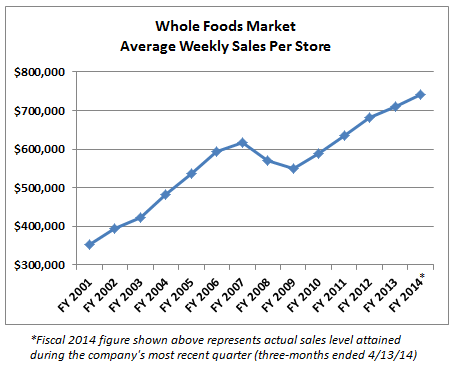"We believe we can build a better mouse trap."
-- Eddie Lampert (CEO), 2014 Sears Holdings Annual Shareholders Meeting
Sears believes that they can build "Shop Your Way" into a profitable and successful multi-channel online retail platform and that it will have a meaningful position in the marketplace alongside Amazon, eBay, Wal-Mart, Target, Macy's, and every other retailer out there. Given how much the Sears and Kmart brands have eroded over the years, coupled with retail industry competition that has only increased during that time, I believe such an investment is a waste of shareholder capital. Skeptics aside, the company continues to press on, but it's not pretty. Sears Holdings today reported more red ink in their second quarter results.
Now, it's true that the jury is still out to some extent. Just because Sears and Kmart have been losing customers by the boatloads and burning cash for several years running does not mean that Shop Your Way can't work. When you have more than 1,800 stores nationwide and tens of billions in annual sales, there are clearly people who are willing to do business with you. It really comes down to whether or not you can serve them in a satisfactory way.
Along those lines, I decided to give Shop Your Way a try. They've been building this platform for several years, so most of the kinks should have been worked out by now. And while I would never suggest that anyone make investment decisions based on their own personal anecdotal evidence, I do think it is fair to say that one's own experience is likely to be indicative of what is typical in many instances. Below I will detail my two recent experiences with Shop Your Way.
——————————————————————————————————————————————
First I downloaded the company's Shop Your Way mobile app just to play around with it. After linking my wife's Shop Your Way account (she is already a member thanks to sporadic purchases over the years from Lands End -- which until recently was a subsidiary of Sears), I was unimpressed (the $0.88 worth of points in her account notwithstanding). The app lacked a lot of features. Perhaps most glaring was the lack of an order history. If you want to look-up a past purchase you have to login to their full web site rather than use the app. That seems rather odd. You can also not change personal information in your Shop Your Way account, such as password, phone number, email address, etc.
So while there are lots of features missing, there are others that Sears seems to think are important. One is GPS tracking that allows the app to know when you are in a Sears or Kmart store. Your phone will vibrate upon detection of your presence, ask you to post a status update (yes, just like Facebook) and offer you coupons that you can use that day. For avid Shop Your Way users, I can see this being a nice feature.
That said, the other day my wife and I were in Starbucks enjoying a beverage when my phone vibrated. I assume it was a new text message, but no, it was the Shop Your Way app. It wanted me to "check-in" (they call it "shop'in"). At this point I was baffled. Why would I check-in to Shop Your Way at a Starbucks? Are they doing some sort of cross-promotion with the coffee chain?
Well, it turns out there used to be a Sears store in the same complex as this particular Starbucks and since I was within a few hundred feet of it, the app thought I was actually shopping at Sears. Normally I would give them a pass here, since GPS tracking on mobile phones typically is only accurate to within a few hundred feet. But this instance is a little different because this particular Sears store actually closed permanently a few months before. In fact, the app seems to know something isn't quite right. Under the store's details it shows the store's street address as "lease ending 12/31/2015."
So the whole experience is bizarre, but at least I know sales at that Sears store were so bad that they closed the store before the lease was up even though they are still paying rent on vacant space. Pretty telling if you ask me. Anyway, I obliged and submitted a status update as requested. Answering the question "what are you up to?" I simply typed "having breakfast at Starbucks, that Sears store closed months ago." Talk about a first impression.
——————————————————————————————————————————————-
Okay, so the app isn't updated with the company's current store base, but what about making an actual purchase with it? After all, e-commerce is what's of utmost importance here, right? Well, a chance to test things out presented itself recently.
My wife wanted to buy a mini refrigerator for her office at work and I suggested we look at Sears since they are big in the appliance market. After comparing selection and prices, Sears actually did have a fridge that matched best with her desired parameters, so I offered to fire up the Shop Your Way mobile app and complete the purchase, hoping to have the item shipped to the Sears store at our local mall. The purchase went smoothly and the app told us the item would be ready for pick-up in 6-8 days, at which time they would email both of us (I added myself as a pick-up person in case it was more convenient for me to get the item). The time estimate of 6-8 days seemed on the long side (especially if we are comparing the convenience of Shop Your Way to the competition), but since this purchase was not super time-sensitive, waiting a week was fine (the fridge was shipping from Illinois -- where Sears and Kmart are based, which is likely why it would take that long to get to Seattle).
Exactly 7 days later we both received an email alerting us that the fridge was ready to be picked up at the Sears store we had designated. Kudos to Sears for being on-time relative to what was promised. It was downhill from there, however. Here is a screenshot of the email my wife received as it was displayed in Gmail:
Oh boy. Where to begin. Of the four sentences in this email meant to give the customer important information, three of them have problems.
The second sentence appears to be trying to tell me where in this particular store the online order pick-up area is located. That would be very helpful information that would reduce the likelihood that I find myself wandering around the store looking for where to go. But that field was left blank.
The third sentence says that upon arrival at the store you can either scan the bar code at the top of the email or enter the salescheck number in order to initiate the pick-up process. That would be great, aside from the fact that there is no bar code at the top of the email and the salescheck number appears to be a media file that does not load when you view the email (and yes, I made sure that Gmail was set to display all media attachments).
Lastly, the fourth sentence contains another blank field that was clearly supposed to insert my name letting my wife know that I received the same email and could pick-up the item for her.
If you are trying out Shop Your Way for the first time, does this experience scream out "better mouse trap!" to you? Hardly. And we have yet to even make the trip to the store yet. Needless to say, I was dreading the trip since I knew that 1) I did not know where to go, and 2) I knew I was likely to have issues once I got there since I had neither a bar code nor a salescheck number to provide them.
But before we get to that, how about a screenshot of the email they sent me as the designated secondary pick-up person:
So much for thinking/hoping that the first email may have just been a glitch. Houston Hoffman Estates, we have a problem.
The same day my wife and I head to the Sears store to pick-up the fridge. There is one sign on the lower level designating the corner where online pick-up area is located and we walked right past it due to where we happened to park and enter the store, so that was not a problem (but it might very well be if you entered from the interior mall entrance directly, as there were no signs pointing us in the right direction). In the designated pick-up area there is a kiosk sitting outside of the warehouse area where they keep the inventory stored. Fortunately, you can use your credit card or phone number to look up your order if you don't have a bar code or a salescheck number (I guess we are not the only ones to have this problem, but in that case, why not do away with both and just let people use the phone number linked to their Shop Your Way account for order retrieval?).
After finishing with the kiosk, which was quick and easy, our order is shown on a monitor on the wall that is tracking how long it takes for the item to be brought out to us. The company's goal is 5 minutes or less and on that mark they succeeded. There were two employees working the warehouse area so while there was nobody in plain sight to answer any questions you might have, the kiosk worked just fine. So despite the issues with their email system, this particular Sears store has a perfectly adequate pick-up area. In fact, there were 3 other people picking up items in the 5 minutes or so we were there. If you are looking for a silver lining in all of this, there you go.
Summing everything up, it isn't hard to understand why Sears is losing money. This $100 item likely cost them $70-$75 wholesale. They had to ship it from Illinois to Seattle on their own dime (it was about 50 pounds, so shipping wasn't cheap). Then they incur costs at the store to get the item to the customer when they arrive. The idea that they can compete with Amazon or Wal-Mart or Target or Home Depot in this fashion seems suspect to me. And so far their financial results aren't proving otherwise.










